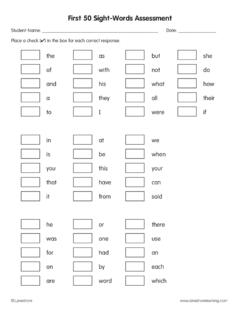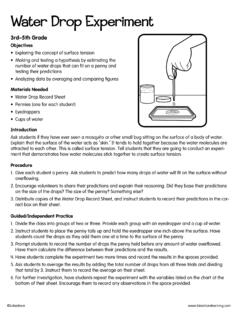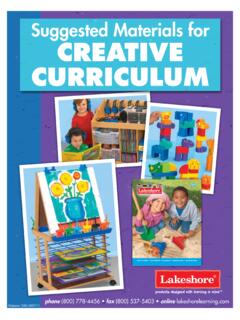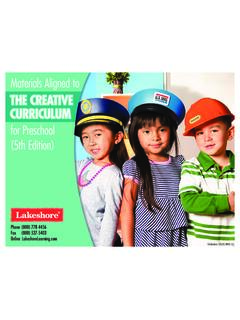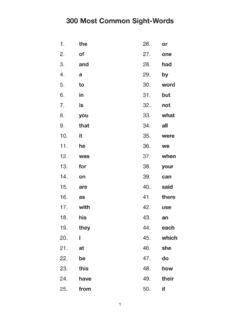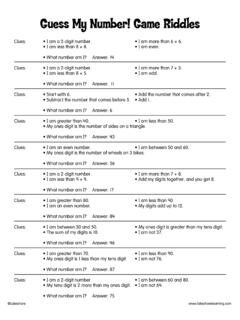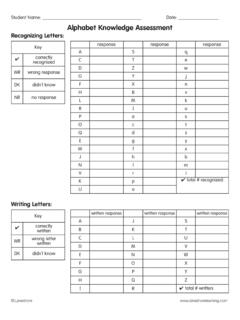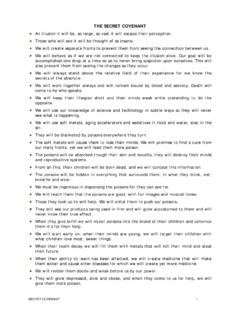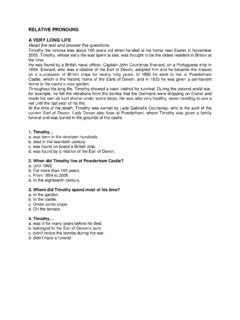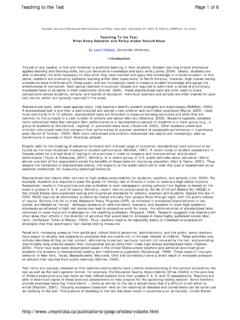Transcription of Force & Motion Activity Tub - Lakeshore Learning
1 Force & Motion Activity TubThe perfect tool to set Learning in Motion , thisall-in-one Activity tub has everything you needto help students learn about Force and materials in the tub give students hands-onexperiences with concepts like gravity, velocity,acceleration, friction, and more. As studentsrace cars on ramps, build roller coasters, andwatch balloon rockets zoom by, they will trulysee Newton s laws in easy-to-follow experiment cards,reproducibles, vocabulary cards, and othersupplies are all designed to support nationalscience standards. The activities are simple toset up and kid-friendly enough for students todo on their own or in small groups. We ve alsoincluded plenty of background information oneach topic, so you can dive right in to theexperiments. As you teach your students aboutforce and Motion , these memorable activitieswill really have an impact on them!
2 NOTE:Each experiment or Activity found in theguide or on the experiment cards features a listof the materials needed to complete it at thetop. Supplies that are provided in the activitytub are shown in bold print,while those youneed to supply yourself are in italics so it salways easy to see exactly what you the Force and Motion Activity Tub Activity guide withreproducibles Wall chart 8 experiment cards 25 vocabulary cards 12 large marbles 5 small marbles 12 straws 12 balloons 36 feet of string 5 feet of tubing Stopwatch Cart launcher 2 wooden carts 2 wooden ramps Measuring tape 2 pieces of sandpaper Storage tubWhat s IncludedStudents will be able to describe Newton s First, Second, and Third Laws of Motion and identify examplesof these laws at work in the world around will know that unbalanced forces cause changes in the speed of an object s will understand qualities of Motion including position, velocity, acceleration, and momentum, aswell as forces which hinder Motion .
3 Like to meet these objectives:DD354 Ages 9+ 2007 Lakeshore (800) 428 - 2/9/07 3:44 PM Page 1 Background InformationThe Basics of Force and Motion .. 4 Activities & ReproduciblesActivity 1 KWL Chart .. 6 Activity 2 Newton s First Law .. 6 Activity 3 Introducing Inertia .. 7 Activity 4 Force & Motion Dictionary .. 8 Activity 5 Force & Motion Experiment 1 .. 8 Activity 6 Balancing Act .. 9 Activity 7 What Is Friction? Experiment 2 .. 9 Activity 8 What s the Speed? Experiment 3 .. 10 Activity 9 Cart Launcher Experiment 4 ..10 Activity 10 Newton s Second Law .. 11 Activity 11 Newton s Third Law .. 11 Activity 12 Rocket Race Experiment 5 ..12 Activity 13 Push & Pull Posters .. 12 Activity 14 Reaction Racers .. 13 Activity 15 Marble Momentum Experiment 6 .. 14 Activity 16 Roller Coaster Experiment 7 ..14 Activity 17 Catch That Can! .. 15 Activity 18 Marble Race Experiment 8.
4 16 Activity 19 Where s That Word? .. 16 Activity 20 Laws of the Land: Newton & Seat Belts .. 17 Reproducible: Newton s First Law .. 18 Reproducible: Vocabulary Dictionary ..19 Reproducible: Science Log Sheet .. 20 Reproducible: Newton s Second Law ..21 Reproducible: Newton s Third Law .. 22 Reproducible: Where s That Word? .. 23 Reproducible: Write an Article .. 24 Assessment .. 25 Assessment Answer Key .. 27 Notes ..28 Table of 2/9/07 3:44 PM Page 3 The Basics of Force & MotionA forceis a push or a pull. Much of what we know about forces and their resultingmotions comes from the ideas of Sir Isaac Newton. A mathematician and scientist, Newtonlived in England during the 1600s. He published his observations and theories about forceand Motion in 1687. Even though Newton s document is now hundreds of years old, the three laws he presented are still the foundation of modern physics.
5 To explore Force and Motion , weneed to understand Newton s three laws and be able to identify them in the world around s First Law of Motion An object at rest tends to stay at rest, and an object in Motion tends to stay inmotion, unless acted upon by an outside, unbalanced s First Law basically argues that objects whether they are staying still ormoving tend to keep on doing what they re doing until something interferes. When we putsomething down, it tends to stay in that spot until someone or something moves it. Thesecond part of this law that a moving object will stay in Motion is more difficult to s hard to picture an object in Motion forever since moving objects always seem to slowdown at some objects slow down or stop moving, it s always due to an outside Force , like frictionor air when two objects rub against each other. As a skier movesover the snow, the contact between the skis and the snow creates sliding friction.
6 An object(like a skateboard) rolling over a surface creates rolling s First Law is also called the law of inertia. Inertiais another word to describe anobject s tendency to stay in Motion or at rest unless an outside Force and Unbalanced ForcesNewton s First Law of Motion assumes that the forces acting on the object are a book is at rest on a table, the Force of gravity pushing down on the book is equal tothe Force of the desk pushing up. The forces acting on the book are balanced, so the bookstays put. The same is true of objects in Motion . If the forces acting on a moving object arebalanced, and no other outside forces interfere, the object would keep on moving forcescause a change in position or Motion . If two people are arm wrestlingand both exert the exact same amount of Force , their arms will be deadlocked in the samespot. The balanced forces cancel each other out, causing a state of equilibriumwhere thereis no Motion or change.
7 As soon as one person exerts more Force , the forces becomeunbalanced. Unbalanced forces always result in Motion . In the case of the arm wrestling, thestronger arm will overtake the weaker arm and push it an object is set into Motion , we can measure how fast it travels and calculate itsspeed. We can also calculate the velocity, which describes the speed and direction of amoving object. If the moving object travels at the same, unchanging velocity, it has aconstantspeed. A change in velocity (speeding up) causes 2/9/07 3:44 PM Page 4 Newton s Second Law of Motion Acceleration of an object depends on the Force and Newton s First Law describes how objects behave when forces are balanced, hissecond law is about what happens when two forces are unbalanced. Newton s Second Lawsays that once an object is set in Motion , its acceleration will depend on two things: Force andmass.
8 In fact, this law of Motion is often expressed as an equation: Force equals mass timesacceleration(F = ma). Force and acceleration are proportional to each other the amount of Force is equal tothe amount of acceleration. The greater the Force exerted on an object, the more it willaccelerate. For example, the harder you kick a ball, the farther and faster it will opposite is true of mass. The more mass an object has, the less it will accelerate. If youkick a tennis ball and a bowling ball with the same amount of Force , the heavy bowling ball isgoing to move slower and go a shorter distance than the tennis ball. A heavier objectrequires more Force to set it in s Third Law of Motion For every action, there is a reaction that is equal in magnitude and opposite always occur in pairs, and Newton s Third Law of Motion helps us understand therelationship between pairs of forces.
9 Every time a Force , or action, occurs, it causes a can describe the reaction in terms of its strength, or magnitude, and also its magnitude of the action is equal to the magnitude of the reaction. For example, if youtoss a pebble into the water, it s going to create a small ripple or splash. If you hurl a largeboulder at the water, the splash is going to be bigger. The Force of the action and reactionalways match an action and its reaction are equal in magnitude, they are opposite in rock plunges down into the water, but the water splashes up. When you throw or shootsomething forward, the recoil of the Force pushes you backward. Every time a Force acts on anobject, it causes a reaction Force in the opposite & Potential EnergyEnergyis the ability to do work. An object doesn t have to be in Motion to energyis energy that s stored in an object. (In fact, it s also referred to asstored energy.)
10 An object s position or circumstances give it potential energy. A spring onthe bottom of a pogo stick has potential energywhen someone is standing on the pogostick. The coil of the spring compresses when pressure is applied, storing up energy that willlater be released. The more height and mass an object has, the more gravitational potentialenergy it an object is in Motion , it has kinetic energy. When the spring compresses andreleases, the kinetic energy of the spring pushes the pogo stick and its rider up into the the person jumps on the pogo stick and the spring compresses again, more potentialenergy is stored in the spring. When the spring releases, the kinetic energy of the springpushes the rider up once 2/9/07 3:44 PM Page 5 What You Need Newton s First Law(page 18)DirectionsInvite students to share what they know about SirIsaac Newton. Some of them may recognize that hediscovered the idea of gravity.
